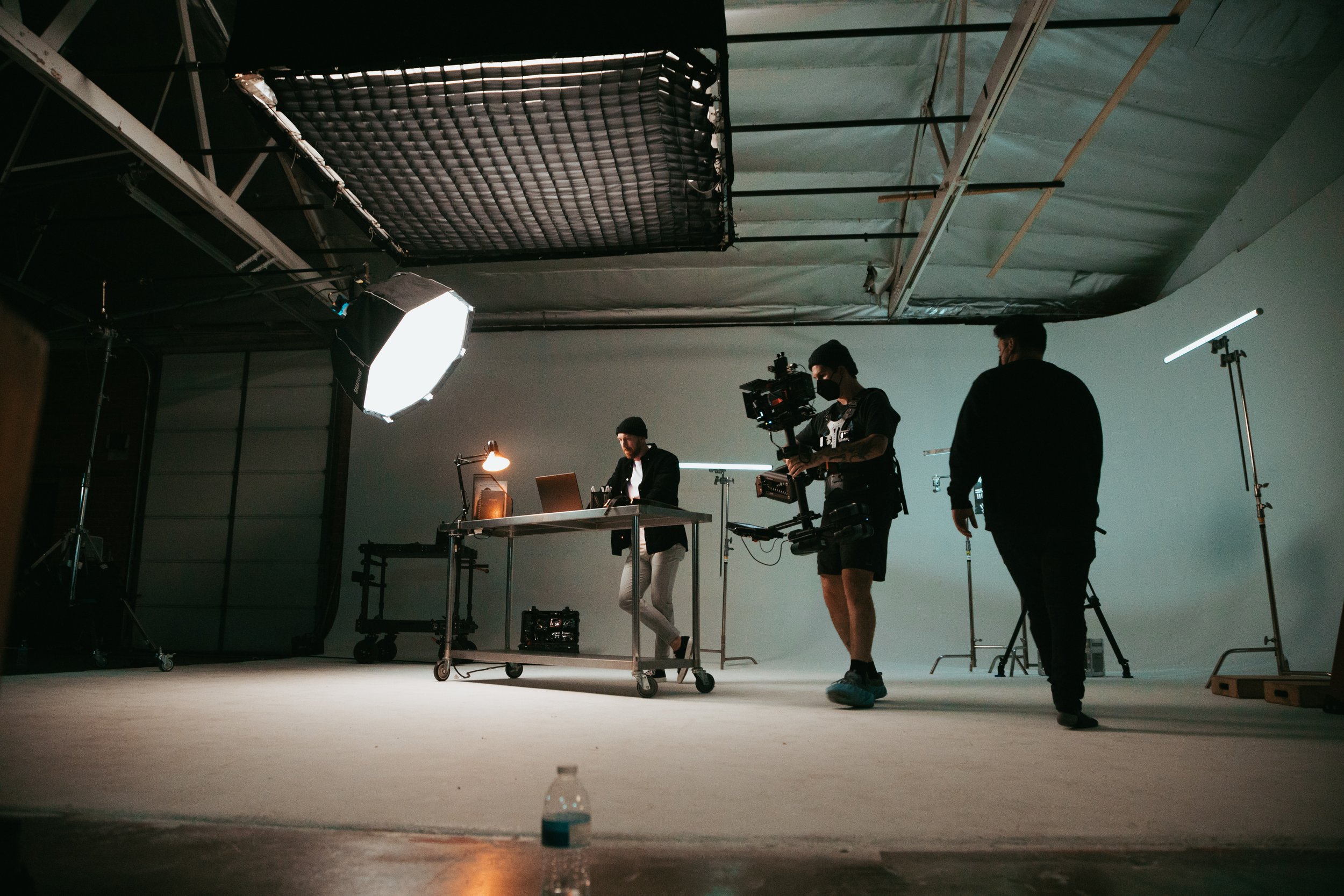Mastering the Steps of Video Production
The video production process can be lengthy and complicated. Mastering each of its steps will help you tell a compelling narrative and leave a lasting impression on viewers. Let's dive into the different phases of the video production process, and what you need to know about each one.
Key Takeaways
Mastering video production requires understanding the three phases of video production: pre-production, production and post-production.
The Pre-production stage involves establishing objectives, target audience and scripting or storyboarding
The Production stage consists of equipment setup, recording & filming techniques.
The Post-production stage involves editing video clips, adding graphics, color correction, sound design, & visual effects.
Understanding the Video Production Process
A video production company in the middle of the video production process
The video production process is a sequential series of steps from the initial concept to the completed video. Whether you are working with a video production company or handling video production in-house, understanding every phase will make sure resources are used effectively.
The Three Phases of Video Production
The video production process is composed of three different stages - pre-production, production (filming and/or animation) and post-production.
In the pre-production phase, you will create a blueprint for your project by deciding on goals, understanding who your target audience is, constructing a script as well as a storyboard, choosing locations and talent to fit the needs of your video project.
The next phase is the production phase which involves recording and bringing your ideas to life. Setting up equipment at each of your planned locations, filming each scene, and adapting when unexpected difficulties arise sum up this stage of the process
The final phase is the post-production stage, where video clips are edited, sound design is incorporated and graphics are applied where necessary.
Importance of Following a Structured Process
Having a clear and organized process is critical to achieving success. The pre-production process is especially important because it lays down the foundation for the production and post-production stages.
The Post production process involves many small changes that can make a huge impact on the final video content as well.
Pre-Production: Laying the Foundation
An image illustrating the steps of video production during the pre-production phase
The pre-production phase of any video project is all about laying the foundations for success. During this stage, you’ll set objectives and identify your target audience while developing scripts. You'll also develop storyboards, scout suitable locations and talent if necessary.
Careful planning during pre-production ensures smooth production & post-production phases. Breaking down each key element within this initial preparation phase will provide an effective approach to realizing your vision, no matter how large or small it may be!
Identifying Objectives and Target Audience
Before beginning the video production process, it is essential to identify and define your target audience. Understanding who your video should speak to will help you set up a focused strategy in order to achieve specific objectives.
Customizing the content of your video according to who you are aiming for guarantees that viewers will be engaged with its material. Video strategy here is key!
Scriptwriting and Storyboarding
In order to ensure a successful outcome and stay on schedule, pre-production processes such as scriptwriting and storyboarding are essential. Consider visuals, dialogue, and narrative, as important elements for your production.
Storyboarding in particular, helps establish what each scene should look like and serves as a guiding handbook for production teams in the middle of the production phase. Without this crucial preparatory stage, there would be no clear direction or focus during the filmmaking process, so great care must be taken to create detailed scripts that cover all your bases before beginning the production phase.
Location Scouting and Talent Acquisition
Scout locations and hire actors for your video to create believable scenes that will fit your video's narrative. Locations chosen will give your audience a sense of atmosphere, while finding ideal talent will help bring out your core message.
Production: Bringing Your Vision to Life
A video production team setting up equipment for filming
The production phase is the point at which your project really comes to life, as you shoot or animate all the footage. Production usually involves setting up gear, recording everything that needs to be captured and troubleshooting any unexpected issues.
In the next section, we will explore what constitutes a successful Production process.
Equipment Setup and Preparation
Proper setup and preparation of camera, sound, and lighting equipment is crucial for creating a high quality final video.
To ensure a smooth filming process and capture the best shots, it is important to get the technical aspects right before starting the actual recording. You don't want to be worrying about your equipment while capturing footage, so make sure to set it up properly at the very start.
Filming Techniques and Best Practices
Effective professional video production involves utilizing efficient filming practices and employing specific techniques to create visually appealing videos that emotionally connect with viewers. Examples of techniques can include camera positioning, framing, composition, lighting, and angles – all coming together to create a specific aesthetic for maximum impact on audiences.
Managing Unexpected Challenges
To make sure your production schedule stays on track, it’s important to prepare for any potential issues that may come up. Typical problems can include budget limitations, sound difficulties, unanticipated weather changes, and rewrites in the script.
Malfunctioning video equipment or difficulty accessing talent can be huge roadblocks as well. By proactively implementing creative solutions, it's possible to overcome obstacles and maintain video output.
Post-Production: Polishing Your Masterpiece
A video editor working on a video project
The post-production phase is the final stage of the filmmaking process, raw footage is assembled into a fully completed high-quality video. At this point, all your footage is edited. The editing process includes adding graphics, sound mixing, adding background music, removing background noise, and much more
At the end of the post-production phase, your finished video should be able to deliver a core message that resonates with the target audience you identified during the pre-production stage.
Editing and Assembly
When it comes to producing the ideal video, selecting and organizing footage is a crucial step. An experienced video editor should be able to leverage video editing software to select all of the best takes, assemble them together, and add visual effects along with music for extra impact.
The editing process can make or break your production, so make sure to take the time and care necessary before crossing the finish line!
Graphics, Animations, and Visual Enhancements
Incorporating graphics like logos, graphs and animations can bolster your video’s visual appearance while helping to convey the message effectively. These elements will make it easier for viewers to understand key points and give them a more exciting viewing experience.
Graphics are an excellent way of sprucing up any video. Allowing you to add depth and dynamism that could otherwise be missing.
Sound Design and Final Touches
The addition of audio such as music and narration to your video can significantly increase its impact. This technique helps produce a more immersive experience for the viewer while also successfully evoking emotions based on the mood of the music chosen.
Tips for Collaborating with a Video Production Team
A video production team discussing a video project
Cooperating with a video production team calls for reliable communication, organized planning, and an orderly review/feedback system. These elements are key to working harmoniously alongside your production crew.
This section will explain the importance of having an open dialogue between all parties as well as organizing and getting everyone on the same page.
Communication and Planning
The key to a successful video production lies in transparent communication and organized planning within the production team.
Ensuring that everyone is on the same page will help keep tasks moving along quickly, while effective preparation allows for an efficient workflow.
Keeping clear lines of discussion open keeps all involved parties informed so they can act swiftly within set timelines.
Review and Feedback Process
In order to create an impressive finished video, it is beneficial to establish a clear review and feedback process.
Software such as Frame.io, Dropbox, Wipster, and Filestage are advantageous tools that assist in simplifying the review and feedback process.
Summary
Understanding the steps within the video production process is paramount to ensure you create an engaging piece of content that resonates with your audience.
Make sure you understand all of the important elements of pre-production, production and post-production to ensure success.
Communication should remain open when working with any video production crew. Finally, be prepared for unexpected challenges while shooting and editing footage.
Now it’s time to get out there and produce your masterpiece!
Frequently Asked Questions
What are the 5 stages of video production?
Video Production is a process composed of five main components: Pre-Production, Production, Post-Production, Distribution and Evaluation. Knowing each step well will ensure the video reaches its greatest potential. All these elements must work in harmony to create an impactful final product.
What is the basic workflow of video production?
The video production workflow is an ordered process which consists of tasks such as brainstorming, sketching storyboards, capturing elements and editing to ensure the project meets quality standards while staying on schedule.
What are the 8 elements of video production?
When it comes to video production, some key points must be taken into account for success - length, clarity of message, format and sound quality are all crucial elements. Lighting and editing should also not be overlooked. Captions are also important depending on the chosen hosting platform.
What is the importance of following a structured process in video production?
Sticking to an organized methodology in video creation helps make the most of resources, streamlines tasks, and leads to success.
How can I ensure effective communication and planning with my video production team?
To ensure effective interaction and coordination with your video production crew, you should set precise objectives and goals, maintain consistent open dialogue, and promptly respond to concerns raised by team members. It's also a good idea to assign a designated person of contact for team members to reach out to with questions. Finally, an organized feedback system during post-production will help with refining the finished video!






